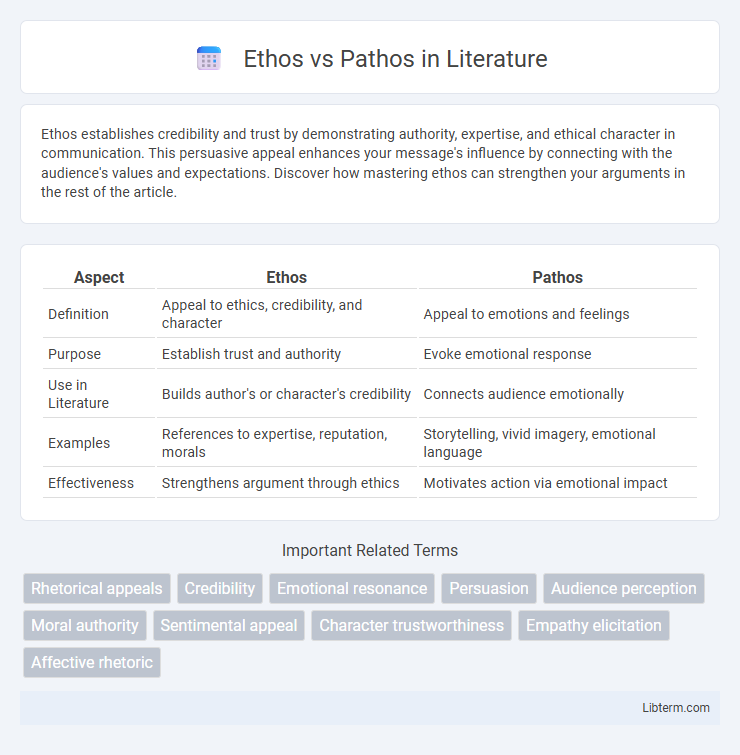Ethos establishes credibility and trust by demonstrating authority, expertise, and ethical character in communication. This persuasive appeal enhances your message's influence by connecting with the audience's values and expectations. Discover how mastering ethos can strengthen your arguments in the rest of the article.
Table of Comparison
| Aspect | Ethos | Pathos |
|---|---|---|
| Definition | Appeal to ethics, credibility, and character | Appeal to emotions and feelings |
| Purpose | Establish trust and authority | Evoke emotional response |
| Use in Literature | Builds author's or character's credibility | Connects audience emotionally |
| Examples | References to expertise, reputation, morals | Storytelling, vivid imagery, emotional language |
| Effectiveness | Strengthens argument through ethics | Motivates action via emotional impact |
Understanding Ethos: The Power of Credibility
Ethos represents the ethical appeal that establishes a speaker's credibility and trustworthiness, crucial for persuasive communication. Demonstrating expertise, moral character, and reliability strengthens ethos, making audiences more likely to accept arguments. Effective use of ethos leverages authority and authenticity, enhancing the overall impact of rhetoric in fields such as law, marketing, and leadership.
Pathos Explained: Appealing to Emotions
Pathos appeals to emotions by targeting feelings such as fear, love, anger, or joy to influence an audience's response. This rhetorical strategy relies on storytelling, vivid imagery, and emotional triggers to create a connection between the speaker and the audience. Effective use of pathos can evoke empathy, passion, or urgency, driving the audience to align with the speaker's message or call to action.
Ethos vs Pathos: Key Differences
Ethos and Pathos serve distinct roles in persuasive communication, where Ethos establishes the speaker's credibility and authority, influencing the audience's trust through ethical appeal. Pathos targets the audience's emotions, aiming to evoke feelings such as empathy, fear, or passion to motivate action or belief. Understanding these key differences enhances effective rhetoric by balancing logical credibility with emotional connection.
Building Trust with Ethos
Building trust with ethos involves establishing credibility and authority through expertise, reliability, and ethical behavior. Demonstrating knowledge and aligning with the audience's values fosters confidence and persuades through character rather than emotion. Effective use of ethos ensures that the audience perceives the speaker or brand as trustworthy and dependable.
Evoking Emotions with Pathos
Pathos leverages emotional appeal to connect with the audience by triggering feelings such as empathy, fear, or passion, thereby enhancing persuasive impact. It employs vivid storytelling, powerful imagery, and relatable anecdotes to create an emotional bond that motivates action or belief. This emotional resonance increases message retention and influence, distinguishing Pathos as a critical strategy in effective communication.
When to Use Ethos in Persuasion
Ethos should be used in persuasion when establishing credibility and trustworthiness is crucial to influencing an audience. It is most effective in professional settings, expert testimony, or situations where the speaker's authority and ethical character enhance the argument's validity. Employing ethos appeals to logic by showcasing expertise, experience, and moral integrity to gain audience confidence.
When Pathos is Most Effective
Pathos is most effective when appealing to the audience's emotions is crucial for persuasion, such as in storytelling, advertising, or motivational speeches. Emotional triggers like empathy, fear, or passion create a strong connection, making the message more memorable and impactful. This technique works best in campaigns related to charity, social justice, or any cause requiring urgent action and personal involvement.
Combining Ethos and Pathos in Argumentation
Combining ethos and pathos in argumentation enhances persuasive impact by establishing both credibility and emotional connection with the audience. Ethos builds trust through expertise and ethical appeal, while pathos engages feelings to motivate action or agreement. Effective arguments integrate factual evidence with compelling narratives to resonate logically and emotionally, driving stronger conviction.
Common Mistakes in Using Ethos and Pathos
Common mistakes in using ethos involve overreliance on authority without demonstrating genuine credibility, which can lead audiences to perceive the speaker as untrustworthy or insincere. In pathos, errors often include exaggerating emotions or manipulating feelings excessively, resulting in emotional fatigue or skepticism from the audience. Effective persuasion requires balancing ethical appeal and emotional connection to maintain authenticity and resonance.
Enhancing Communication: Mastering Ethos and Pathos
Mastering ethos and pathos enhances communication by establishing credibility and appealing to emotions, creating a balanced persuasive message. Ethos builds trust through expertise and ethical appeal, while pathos engages the audience's feelings to foster connection and motivation. Effective communicators integrate ethos and pathos to influence decision-making and strengthen audience engagement.
Ethos Infographic

 libterm.com
libterm.com